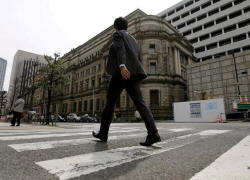|
BOJ to make negative
rates centerpiece of future easing: sources
 Send a link to a friend
Send a link to a friend
 [September 14, 2016]
By Leika Kihara [September 14, 2016]
By Leika Kihara
TOKYO (Reuters) - The Bank of Japan
will consider making negative interest rates the centerpiece of
future monetary easing by shifting its prime policy target to
interest rates from base money at its review next week, sources
familiar with its thinking say.
The change would underscore growing concerns in the central bank and
financial markets over the limits to the BOJ's economic stimulus
efforts, as more than three years of aggressive bond buying is
draining market liquidity.
It would also be a shift away from the BOJ's unique monetary
experiment that attempted to crush yields across the curve and try
to convince the public that its massive money printing will boost
economic activity and prices.
"Among the BOJ's policy tools, the priority will likely shift more
towards interest rates and away from huge bond purchases," said one
of the sources on condition of anonymity.
The Nikkei reported earlier on Wednesday that the BOJ will put more
emphasis on negative rates as a tool for future easing.
The BOJ is unlikely to abandon its current base money target, which
is the amount of money it commits to print each year, or adopt an
explicit cap on long-term rates, they said.
Still, by shifting its policy focus to negative rates, the BOJ hopes
to dispel growing market views that the unpopularity of negative
rates among the public would discourage it to cut rates, even if it
would arrest unwelcome rises in the yen.

A prolonged period of indecision by the Federal Reserve could
undermine the dollar and push up the yen, which has already surged
nearly 17 percent so far this year, pressuring Japan's export
machine.
There is no consensus in the BOJ yet on whether to deepen negative
rates at the Sept. 20-21 meeting, when it conducts the comprehensive
assessment of its policies, the sources said.
That decision will depend on yen moves and whether the board members
feel that doing so would be necessary to reinforce the bank's
commitment to achieving its inflation target, they said.
Most BOJ board members prefer such a modest fine-tuning of the
current policy framework. But with markets increasingly expecting
some form of easing at the review, more radical options are not off
the table, such as ditching setting an explicit cap on bond yields,
they said.
MIDDLE GROUND?
The BOJ shocked markets and the government in January by adding
negative rates to its massive asset-buying program launched in 2013.
Under that scheme, it has pledged to increase base money at an
annual pace of 80 trillion yen ($777 billion) via purchases of bonds
and risky assets.
Many BOJ officials have grown doubtful about how much effect
increasing base money has had in heightening inflation expectations.
But they are equally wary of entirely abandoning the base money
target, the bank's prime policy target, for fear of triggering
market fears it will taper its asset buying.
Policymakers got a taste of how markets might react to that this
week as investors dumped longer-dated bonds on fears the BOJ will
slow the pace of its purchases. The 30-year JGB yield rose to a
six-month high while the 20-year JGB yield rose to 0.495
percent, a level last seen in March.
[to top of second column] |

A businessman walks past the Bank of Japan (BOJ) building in Tokyo,
Japan, March 23, 2016. REUTERS/Toru Hanai/File Photo

The BOJ will thus maintain the base money target and the pace of asset
purchases. But it will consider changing its prime policy target to the 0.1
percent negative rate it now charges for a portion of excess reserves financial
institutions park with the bank, the sources said.
"The base money target does not need to be removed because there is indeed some
positive effects to it," said a source familiar with the BOJ's thinking.
"But it's feasible to focus more on keeping short-term interest rates low," the
source said.
The BOJ says it has three easing tools: buying more bonds, buying more risky
assets and deepening negative rates.
At next week's review, it will likely signal markets that cutting rates would be
the more preferred future option as it directly pushes down short- to
medium-term rates that have the biggest impact on corporate borrowing costs.
The BOJ will also consider reducing purchases of super-long government bonds to
give financial institutions such as insurers and pension funds a better
environment for earning returns, the sources said.
Purchases of shorter-term bonds could be increased to compensate, so that the
overall bond buying amount would not decrease, they said.
To justify concentrating its purchases on short-term debt, the BOJ will issue an
analysis showing that lowering yields of up to 10 years has a bigger positive
impact on the economy than pushing down longer-dated yields, sources said.
The BOJ is likely to maintain its pledge to hit its 2 percent inflation target
"at the earliest date possible."
But with over three years having passed since deploying its asset-buying
program, the central bank will abandon the two-year timeframe it set for
achieving the price goal, they said.
With consumer inflation stuck near zero, the BOJ has been forced to repeatedly
push back the target, most recently to the March 2018 end of fiscal 2017.
(Editing by Eric Meijer and Kim Coghill)
[© 2016 Thomson Reuters. All rights
reserved.] Copyright 2016 Reuters. All rights reserved. This material may not be published,
broadcast, rewritten or redistributed.

 |